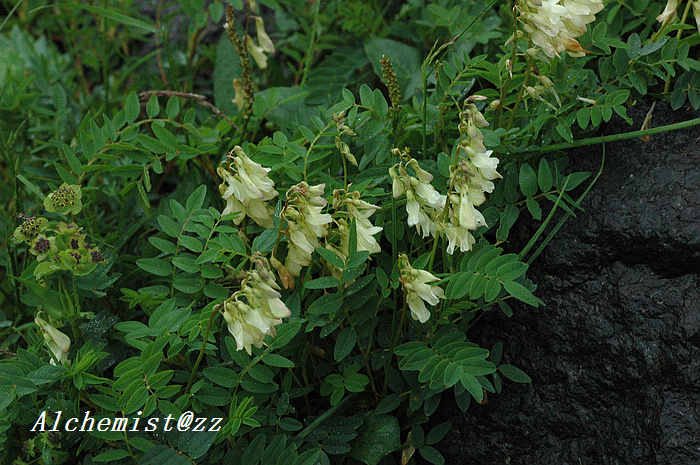- Scientific Name: Hedysarum vicioides subsp. japonicum (B.Fedtsch.) B.H.Choi & H.Ohashi
- Ref: J. Jap. Bot. 63:60. 1988
- Synonyms: Hedysarum iwawogii H.Hara, H. komarovii B.Fedtsch., H. ussuriense Schischk. & Kom., H. vicioides var. chinense B.H.Choi & H.Ohashi
- English Common Name: Japanese sweetvetch
- Chinese Common Name: 拟蚕豆岩黄耆 nǐ∙cándòu yán∙huángqí, 长白岩黄芪 Chángbái yán∙huángqí
- Japanese Common Name: イワオウギ [岩黄蓍]
- Family: Fabaceae
- Genus: Hedysarum
- Distribution: Forests, subalpine meadows; 2500-3200 m. Hebei, E Jilin, NE Liaoning, Sichuan [N Korea, Russia (Far East)].
- Photo: Mt. Changbai, Jilin
Herbs, perennial, 30-50 cm tall. Stems caespitose, erect. Stipules broadly lanceolate, 1-1.2 cm, connate farther than middle. Leaves 7-15 cm, 11-19-foliolate; leaflet blades long ovate, 1-2.3 × 0.6-1.1 cm, abaxially pubescent along veins, adaxially glabrous. Racemes dense, with many flowers; bracts lanceolate, slightly shorter than pedicel, caducous; peduncle slightly longer than leaves. Pedicel 5-6 mm. Calyx obliquely campanulate, 5-6 mm, sparsely pubescent; teeth unequal, most abaxial tooth 0.7-1.5 × as long as tube, other 4 teeth triangular and 1/4-1/3 as long as tube. Corolla yellow; standard long obovate, 1.4-1.6 cm; wings ± as long as standard; keel ca. 2 mm longer than standard. Ovary glabrous or pubescent. Legume divided into 2 or 4 articles; articles subglobose to ovoid, 6-7 × 4-5 mm, compressed, glabrous or pubescent, margin narrow and irregularly dentate. Fl. Jul-Aug, fr. Aug-Sep. (Flora of China)
